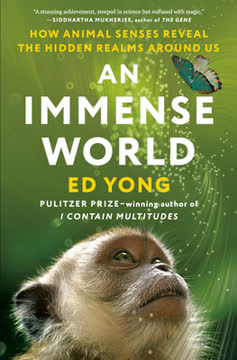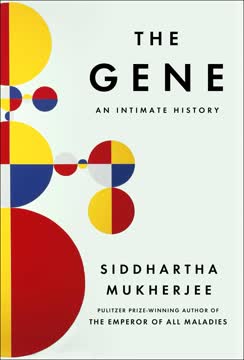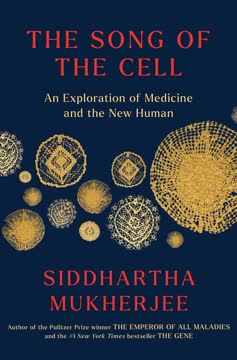Key Takeaways
1. Cancer's Story: An Ancient, Shifting Foe
In a sense, this is a military history--one in which the adversary is formless, timeless, and pervasive.
Ancient origins. Cancer is not a modern disease; evidence of it has been found in mummies and ancient texts, dating back thousands of years. The Edwin Smith Papyrus, written around 2500 BC, describes breast tumors, and Herodotus's Histories mention Atossa, a Persian queen who had a breast tumor. These early accounts reveal that cancer has long been a part of the human experience.
- Mummified remains of the Chiribaya tribe in Peru show evidence of bone tumors.
- Ancient texts from Egypt and Persia describe tumors, though without effective treatments.
A shifting identity. Cancer's understanding has evolved over time, from a "suppuration of blood" to a disease of cellular overgrowth. Early theories attributed it to imbalances in bodily fluids (humors), but the discovery of cells and their role in growth led to a new understanding of cancer as a disease of uncontrolled cell division.
- Rudolf Virchow's cellular theory of disease shifted the focus from humors to cells.
- Cancer is now understood as a disease of pathological hyperplasia, where cells divide uncontrollably.
A persistent challenge. Despite its ancient roots, cancer has remained a persistent and formidable foe. Its ability to adapt, mutate, and spread makes it a complex and challenging disease to combat. The disease has been described as "formless, timeless, and pervasive," highlighting its enduring nature.
2. The Dawn of Chemotherapy: A Chemical Gauntlet
In the end, cancer truly emerges, as a nineteenth-century surgeon once wrote in a book's frontispiece, as "the emperor of all maladies, the king of terrors."
A new approach. Sidney Farber, a pathologist, shifted his focus from studying dead tissues to treating live patients, marking a turning point in cancer treatment. He chose to focus on leukemia, a disease that could be measured by counting cells in the blood, making it possible to assess the effectiveness of new drugs.
- Farber's work was inspired by the discovery of vitamins and their role in blood cell production.
- He sought to use "antivitamins" to block the growth of leukemia cells.
The first chemical weapon. Farber's initial experiments with folic acid were disastrous, accelerating leukemia growth. However, this led to the discovery of antifolates, such as aminopterin, which could temporarily halt leukemia cell growth.
- Aminopterin was the first chemical to induce remissions in childhood leukemia.
- This discovery marked the beginning of chemotherapy as a viable cancer treatment.
A new era. Farber's work, though initially met with skepticism, opened a new era in cancer treatment. It demonstrated that cancer, even in its most aggressive forms, could be treated with chemicals, laying the foundation for future research and development of anticancer drugs.
- Farber's work was a gauntlet thrown down for cancer medicine.
- It was up to an entire generation of doctors and scientists to pick it up.
3. Radical Surgery's Rise and Fall: Cutting Away the Darkness
There were few successes in the treatment of disseminated cancer. . . . It was usually a matter of watching the tumor get bigger, and the patient, progressively smaller.
The era of radical surgery. The late 19th and early 20th centuries saw the rise of radical surgery, with surgeons like William Halsted believing that aggressive removal of tumors and surrounding tissues was the key to curing cancer.
- Halsted's radical mastectomy involved removing the breast, chest muscles, and lymph nodes.
- This approach was based on the "centrifugal theory" of cancer spread.
The limits of radicalism. Despite its initial promise, radical surgery often failed to prevent cancer recurrence. The focus on local removal overlooked the systemic nature of many cancers.
- Halsted's mastectomy, while technically impressive, did not significantly improve survival rates.
- The procedure often left patients disfigured and with limited mobility.
A shift in perspective. The limitations of radical surgery led to a reevaluation of treatment strategies. Surgeons like Geoffrey Keynes and George Crile began to explore less invasive approaches, combining local surgery with radiation.
- They challenged the notion that "more is better" in cancer surgery.
- This shift paved the way for more targeted and less disfiguring treatments.
4. The Power of Measurement: Counting Cancer's Cells
Science begins with counting. To understand a phenomenon, a scientist must first describe it; to describe it objectively, he must first measure it.
Quantifying the invisible. Sidney Farber's focus on leukemia was driven by its unique characteristic: it could be measured. Unlike solid tumors, leukemia cells circulate freely in the blood, making it possible to track their numbers and assess the effectiveness of treatments.
- This ability to measure leukemia cells allowed for the first "experiments" on cancer.
- It transformed cancer medicine into a more rigorous science.
The importance of data. Farber's meticulous record-keeping of blood counts, transfusions, and patient responses was crucial for understanding the effects of his treatments. This emphasis on data collection and analysis became a hallmark of modern oncology.
- Every blood count, every transfusion, every fever, was to be recorded.
- If leukemia was going to be beaten, Farber wanted every minute of that battle recorded for posterity.
A new paradigm. The ability to measure cancer cells in the blood allowed for the development of new therapeutic strategies. It also highlighted the importance of using simple models to understand complex phenomena, a principle that would guide future cancer research.
- Leukemia became a model for understanding other cancers.
- The bacterium would teach him to think about the elephant.
5. The Politics of Cancer: From Private Plague to Public War
The search for a way to eradicate this scourge . . . is left to incidental dabbling and uncoordinated research.
A national response. The rise of cancer as a leading cause of death in the 20th century prompted calls for a coordinated national response. The National Cancer Institute (NCI) was established in 1937, but its efforts were hampered by a lack of funding and political support.
- The NCI was initially a "scientific ghost town" due to neglect and lack of funding.
- Cancer was still a "whispered-about" disease, lacking public attention.
The power of advocacy. Mary Lasker, a socialite with a passion for medical research, played a crucial role in transforming cancer into a national priority. She used her influence and connections to raise awareness and funds for cancer research.
- Lasker's efforts helped to create the American Cancer Society (ACS).
- She understood the importance of political lobbying and public awareness.
A "War on Cancer." The combination of scientific advances and political advocacy led to the launch of the "War on Cancer" in the 1970s. This initiative, while ambitious, also highlighted the challenges of translating scientific discoveries into effective treatments.
- The "War on Cancer" was a bold step, but its timing was overshadowed by other wars.
- It was a political and social movement as much as a scientific one.
6. Targeting Cancer: From Poisons to Precision
The medical importance of leukemia has always been disproportionate to its actual incidence. . . . Indeed, the problems encountered in the systemic treatment of leukemia were indicative of the general directions in which cancer research as a whole was headed.
The limitations of traditional chemotherapy. Early chemotherapy drugs were often toxic and indiscriminate, killing both cancer cells and normal cells. This led to severe side effects and limited effectiveness.
- Chemotherapy was initially a "poison" that pushed the body to its limits.
- The goal was to find a drug that would kill cancer without killing the patient.
The concept of "specific affinity." Paul Ehrlich's work on dyes and antibodies inspired the idea of targeted therapies that could selectively attack cancer cells. He envisioned "magic bullets" that would seek out and destroy cancer cells while sparing normal cells.
- Ehrlich's work laid the foundation for modern targeted therapies.
- He sought a chemical that had a "specific affinity" for cancer cells.
The discovery of targeted therapies. The discovery of molecules like tamoxifen (for breast cancer) and imatinib (for leukemia) marked a turning point in cancer treatment. These drugs targeted specific pathways in cancer cells, leading to more effective and less toxic therapies.
- These drugs were a step toward precision medicine.
- They represented a shift from broad-spectrum poisons to targeted interventions.
7. The Limits of Cure: Prevention and Palliation
The search for a way to eradicate this scourge . . . is left to incidental dabbling and uncoordinated research.
The importance of prevention. While treatment is crucial, prevention is the most effective way to combat cancer. This involves identifying and eliminating risk factors, such as smoking, environmental toxins, and unhealthy diets.
- Cancer prevention requires a shift in focus from treatment to cause.
- It involves addressing the root causes of cancer, not just its symptoms.
The role of screening. Early detection through screening programs, such as mammography and Pap smears, can significantly improve survival rates for certain cancers. However, screening is not a perfect solution and can lead to overdiagnosis and overtreatment.
- Screening can detect cancer in its early, more treatable stages.
- But it also has limitations and can lead to false positives and false negatives.
The need for palliation. Even with advances in prevention and treatment, many patients will still succumb to cancer. Palliative care, which focuses on symptom relief and comfort, is essential for improving the quality of life for these patients.
- Palliative care is not an admission of defeat, but a recognition of the limits of cure.
- It focuses on relieving suffering and improving the quality of life.
8. The Cancer Genome: A Map of Mutations
We reveal ourselves in the metaphors we choose for depicting the cosmos in miniature.
The genetic basis of cancer. Cancer is fundamentally a genetic disease, caused by mutations in genes that control cell growth and division. These mutations can be inherited or acquired through environmental exposures.
- Cancer cells are not simply abnormal; they are genetically altered.
- These alterations can be passed down through generations or acquired during a lifetime.
Oncogenes and tumor suppressors. Cancer cells often have mutations in two classes of genes: oncogenes, which promote cell growth, and tumor suppressor genes, which inhibit cell growth.
- Oncogenes are like "accelerators" that drive cell division.
- Tumor suppressor genes are like "brakes" that prevent uncontrolled growth.
The complexity of the cancer genome. The cancer genome is a complex and dynamic entity, with multiple mutations and alterations that contribute to the development and progression of the disease.
- Cancer cells are not simply clones; they are constantly evolving.
- The cancer genome is a map of mutations, each with its own unique story.
9. The Red Queen's Race: A Perpetual Battle
The secret to battling cancer, then, is to find means to prevent these mutations from occurring in susceptible cells, or to find means to eliminate the mutated cells without compromising normal growth.
The challenge of resistance. Cancer cells are remarkably adaptable and can develop resistance to even the most potent therapies. This requires a constant search for new drugs and treatment strategies.
- Cancer cells are like a moving target, constantly changing and evolving.
- The battle against cancer is a perpetual race against resistance.
The need for new approaches. The limitations of traditional chemotherapy and radiation have led to a search for more targeted and personalized therapies. This involves understanding the unique genetic and molecular characteristics of each cancer.
- The future of cancer treatment lies in precision medicine.
- This approach involves tailoring treatments to the specific needs of each patient.
The importance of perseverance. The battle against cancer is a long and arduous one, requiring patience, resilience, and a willingness to adapt and innovate. There are no easy answers, but the pursuit of knowledge and the commitment to improving patient outcomes must continue.
- The fight against cancer is a marathon, not a sprint.
- It requires a long-term commitment and a willingness to learn from both successes and failures.
10. The Future of Cancer: A New Normal
If we seek immortality, then so, too, in a rather perverse sense, does the cancer cell.
A new era of targeted therapies. The discovery of oncogenes and tumor suppressor genes has led to the development of targeted therapies that can selectively attack cancer cells while sparing normal cells.
- Drugs like Herceptin and Gleevec represent a new generation of cancer treatments.
- These drugs target specific pathways in cancer cells, leading to more effective and less toxic therapies.
The promise of prevention. While treatment is essential, prevention remains the most effective way to combat cancer. This involves identifying and eliminating risk factors, promoting healthy lifestyles, and developing new screening methods.
- Prevention is the key to reducing the incidence of cancer.
- It requires a multifaceted approach that addresses both individual and societal factors.
A new understanding of cancer. The future of cancer medicine will be shaped by a deeper understanding of the disease's biology. This involves studying the genetic and molecular mechanisms that drive cancer growth and spread, as well as the complex interactions between cancer cells and their environment.
- Cancer is not a single disease, but a collection of many different diseases.
- Each cancer has its own unique genetic and molecular profile.
Last updated:
FAQ
What's The Emperor of All Maladies: A Biography of Cancer about?
- Comprehensive history of cancer: The book provides a detailed exploration of cancer's evolution from an ancient disease to a modern medical challenge, covering its biological, social, and medical aspects.
- Biographical approach: Siddhartha Mukherjee presents cancer as a living entity, intertwining personal stories of patients and researchers with the scientific narrative.
- Interdisciplinary insights: The book integrates perspectives from various fields, including medicine, biology, and sociology, to illustrate the complexity of cancer.
Why should I read The Emperor of All Maladies?
- Engaging storytelling: Mukherjee combines scientific rigor with compelling narratives, making complex medical concepts accessible and engaging for readers.
- Insightful exploration: The book offers a profound understanding of cancer's history, biology, and treatment, essential for anyone interested in medicine or public health.
- Cultural significance: It places cancer within a broader cultural and historical framework, examining how societal attitudes toward the disease have evolved.
What are the key takeaways of The Emperor of All Maladies?
- Cancer is multifaceted: Mukherjee illustrates that cancer is a complex interplay of genetic, environmental, and lifestyle factors, crucial for effective prevention and treatment.
- Importance of research: The book highlights the significance of ongoing research and clinical trials in advancing cancer treatment.
- Patient-centered care: Mukherjee advocates for a compassionate approach to cancer treatment, recognizing the emotional and psychological challenges faced by patients.
What are the best quotes from The Emperor of All Maladies and what do they mean?
- "Illness is the night-side of life": This quote by Susan Sontag encapsulates the duality of human existence, reminding us of the inevitability of suffering and the need for compassion.
- "Cancer is a word, not a sentence": Emphasizes that a cancer diagnosis does not define a person's life or future, serving as a reminder of hope and resilience.
- "Cancer is, in essence, a genetic disease": Highlights the central theme of the book, emphasizing the role of genetic mutations in cancer development.
How does The Emperor of All Maladies address the history of cancer treatment?
- Chronological narrative: Mukherjee traces the history of cancer from ancient times to the present, detailing key discoveries, treatments, and societal attitudes.
- Trial and error: The book emphasizes the trial-and-error nature of cancer treatment development, showcasing both successes and failures.
- Impact of societal factors: Mukherjee discusses how societal attitudes toward cancer have influenced treatment options and research funding.
What role do oncogenes and tumor suppressor genes play in cancer, according to The Emperor of All Maladies?
- Oncogenes drive cancer growth: These are mutated genes that promote uncontrolled cell division, leading to cancer.
- Tumor suppressor genes inhibit growth: Normally function to prevent tumor formation, but when inactivated, they allow cancer to develop.
- Balance of signals: The book emphasizes the delicate balance between these genes in maintaining normal cellular function.
How does Mukherjee describe the evolution of cancer treatment?
- Historical context: Mukherjee traces the history of cancer treatment from ancient surgical practices to modern chemotherapy and targeted therapies.
- Shift from radical surgery: Highlights the transition to more nuanced approaches that consider the genetic makeup of tumors.
- Importance of clinical trials: Emphasizes the role of clinical trials in developing new treatments and improving patient outcomes.
What is the significance of chemotherapy in The Emperor of All Maladies?
- Pioneering treatment: Chemotherapy represents a major breakthrough, allowing for the systemic targeting of cancer cells.
- Combination therapies: Mukherjee emphasizes the importance of using multiple drugs together to enhance effectiveness and reduce resistance.
- Challenges and limitations: The book addresses the challenges of chemotherapy, including toxicity and drug resistance.
How does The Emperor of All Maladies portray the patient experience?
- Personal stories: The book weaves in personal experiences of cancer patients, illustrating the emotional and physical toll of the disease.
- Doctor-patient relationship: Mukherjee reflects on the complexities of this relationship, emphasizing empathy and understanding in cancer care.
- Survivorship: Features experiences of long-term survivors, showcasing resilience and hope.
What role does advocacy play in the fight against cancer, according to The Emperor of All Maladies?
- Mobilizing public support: Advocacy efforts have been instrumental in raising awareness and driving policy changes.
- Influencing research priorities: Advocacy has shaped the direction of cancer research, leading to significant advancements.
- Empowering patients: Emphasizes the importance of patient advocacy in giving a voice to those affected by cancer.
How does The Emperor of All Maladies explore the future of cancer treatment?
- Innovative therapies: Mukherjee discusses emerging therapies, including targeted treatments and immunotherapy.
- Personalized medicine: Highlights the shift toward treatments tailored to individual characteristics of a patient's cancer.
- Ongoing challenges: Acknowledges persistent challenges, including drug resistance and the complexity of cancer biology.
What is the Red Queen syndrome in relation to cancer?
- Constant adaptation required: Refers to the need for treatments to continually evolve to keep pace with cancer's ability to resist therapies.
- Implications for treatment: Illustrates the ongoing battle between cancer cells and treatment strategies.
- Social behavior and prevention: Suggests that societal behaviors can rapidly change and influence cancer rates, highlighting the need for continuous public health initiatives.
Review Summary
The Emperor of All Maladies is praised as a comprehensive, well-written history of cancer research and treatment. Reviewers appreciate Mukherjee's ability to explain complex scientific concepts in an engaging manner, blending personal stories with medical information. Many find the book emotionally challenging but ultimately informative and hopeful. Some criticize the focus on American research and occasional repetition. Despite its length and dense subject matter, most readers find it compelling and recommend it for anyone interested in understanding cancer's impact on society and medicine.
Similar Books










Download PDF
Download EPUB
.epub digital book format is ideal for reading ebooks on phones, tablets, and e-readers.







